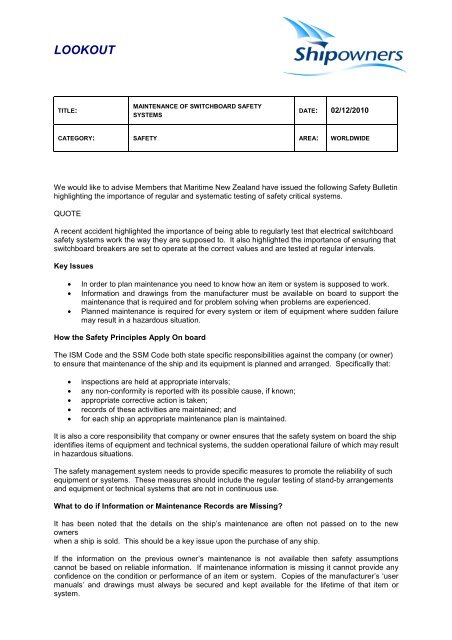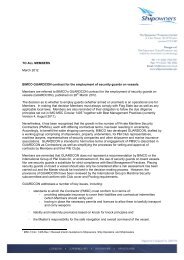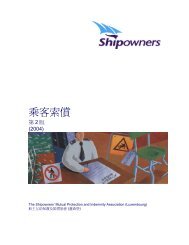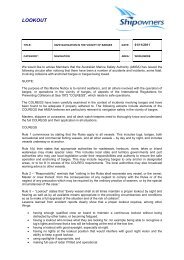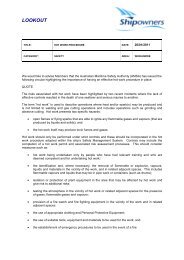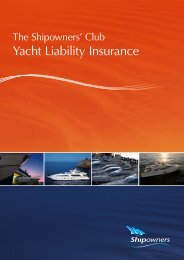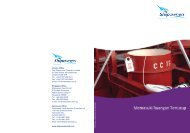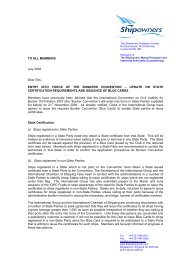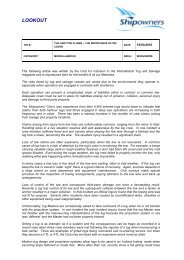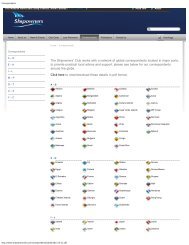Maintenance of Switchboard Safety Systems - Shipowners
Maintenance of Switchboard Safety Systems - Shipowners
Maintenance of Switchboard Safety Systems - Shipowners
You also want an ePaper? Increase the reach of your titles
YUMPU automatically turns print PDFs into web optimized ePapers that Google loves.
LOOKOUTTITLE:MAINTENANCE OF SWITCHBOARD SAFETYSYSTEMSDATE: 02/12/2010CATEGORY: SAFETY AREA: WORLDWIDEWe would like to advise Members that Maritime New Zealand have issued the following <strong>Safety</strong> Bulletinhighlighting the importance <strong>of</strong> regular and systematic testing <strong>of</strong> safety critical systems.QUOTEA recent accident highlighted the importance <strong>of</strong> being able to regularly test that electrical switchboardsafety systems work the way they are supposed to. It also highlighted the importance <strong>of</strong> ensuring thatswitchboard breakers are set to operate at the correct values and are tested at regular intervals.Key Issues• In order to plan maintenance you need to know how an item or system is supposed to work.• Information and drawings from the manufacturer must be available on board to support themaintenance that is required and for problem solving when problems are experienced.• Planned maintenance is required for every system or item <strong>of</strong> equipment where sudden failuremay result in a hazardous situation.How the <strong>Safety</strong> Principles Apply On boardThe ISM Code and the SSM Code both state specific responsibilities against the company (or owner)to ensure that maintenance <strong>of</strong> the ship and its equipment is planned and arranged. Specifically that:• inspections are held at appropriate intervals;• any non-conformity is reported with its possible cause, if known;• appropriate corrective action is taken;• records <strong>of</strong> these activities are maintained; and• for each ship an appropriate maintenance plan is maintained.It is also a core responsibility that company or owner ensures that the safety system on board the shipidentifies items <strong>of</strong> equipment and technical systems, the sudden operational failure <strong>of</strong> which may resultin hazardous situations.The safety management system needs to provide specific measures to promote the reliability <strong>of</strong> suchequipment or systems. These measures should include the regular testing <strong>of</strong> stand-by arrangementsand equipment or technical systems that are not in continuous use.What to do if Information or <strong>Maintenance</strong> Records are Missing?It has been noted that the details on the ship’s maintenance are <strong>of</strong>ten not passed on to the newownerswhen a ship is sold. This should be a key issue upon the purchase <strong>of</strong> any ship.If the information on the previous owner’s maintenance is not available then safety assumptionscannot be based on reliable information. If maintenance information is missing it cannot provide anyconfidence on the condition or performance <strong>of</strong> an item or system. Copies <strong>of</strong> the manufacturer’s ‘usermanuals’ and drawings must always be secured and kept available for the lifetime <strong>of</strong> that item orsystem.
If the details on the last overhaul and last test (based on either set ‘operating hours’ or ‘calendar-timepassed’) are not available on an item or system this should also be highlighted as a potential hazard.Where this is the case the manufacturer’s testing and maintenance requirements should be applied atthe earliest possible opportunity. The sound and detailed reporting <strong>of</strong> maintenance must always beundertaken as it is important information for the future.<strong>Switchboard</strong> <strong>Safety</strong> Surveys, Tests and ReportingThere are many types <strong>of</strong> tests that need to be undertaken to ensure that main electrical switchboardsare safe and operating correctly. Planning maintenance around these required tests and safetychecks is important.So too is recording what tests have been undertaken, a detailed description <strong>of</strong> what was done andwhat the results were. It is important to get electrical surveyor support in arranging the content <strong>of</strong> themaintenance plan for each <strong>of</strong> the main items in a switchboard.Of key importance is the regular survey, testing and recorded testing <strong>of</strong> the following items:• the earthing <strong>of</strong> all structural elements <strong>of</strong> the switchboards (including any doors with lights orcontrols) and provision <strong>of</strong> insulating mats on the floor around the switchboard;• the cleanliness and close visual inspection <strong>of</strong> the elements within the switchboard;• the protection <strong>of</strong> the switchboard from piping systems, condensation or water-ingress;• the functionality <strong>of</strong> all controls, lights and meters (and their appropriate marking and labelling);• the functionality <strong>of</strong> any power management systems (if arranged);• the functionality <strong>of</strong> all automatic control system (any auto-starts or stand-by functions);• the functionality, set-point and delays <strong>of</strong> ‘under-voltage’ circuit breaker trips on the shut-down(or de-clutch) <strong>of</strong> the power generator prime-movers (the ship’s generators or main shaftalternators);• the functionality, set-point and delays <strong>of</strong> ‘reverse-power’ circuit breaker trips for generatoralternators• the functionality, set-point and delays <strong>of</strong> ‘over-current’ circuit breaker trips for generatoralternators, through the simulated ‘secondary injection testing’ on board (or full ‘primaryinjection testing’ ashore);• the functionality and verification <strong>of</strong> the set points <strong>of</strong> the engine room alarm system testedunder both normal and emergency power;• the testing <strong>of</strong> back-up power arrangements (normally batteries), their charging and ability totake over the powering <strong>of</strong> the alarm system without causing failures or false alarms.The interval <strong>of</strong> the above surveys and tests should be discussed with your Surveyor or ClassificationSociety.The time intervals for each survey or test and the supported methods for reporting (and recordkeeping) <strong>of</strong> each one should also be detailed within your planned maintenance system ormaintenance plan.UNQUOTESource <strong>of</strong> information: http://www.maritimenz.govt.nz/Publications-and-forms/Commercialoperations/Shipping-safety/<strong>Safety</strong>-updates/Issue23-mnz-safety-bulletin-august-2010.pdf


